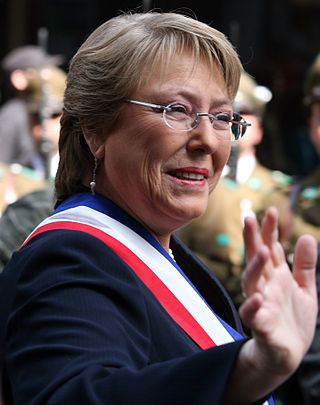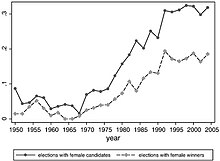
The State of the Union Address is an annual message delivered by the president of the United States to a joint session of the United States Congress near the beginning of most calendar years on the current condition of the nation. The State of the Union Address generally includes reports on the nation's budget, economy, news, agenda, progress, achievements and the president's priorities and legislative proposals.
Affirmative action refers to a set of policies and practices within a government or organization seeking to benefit marginalized groups. Historically and internationally, support for affirmative action has been justified by the idea that it may help with bridging inequalities in employment and pay, increasing access to education, and promoting diversity, social equity and redressing alleged wrongs, harms, or hindrances, also called substantive equality.
Identity politics is politics based on a particular identity, such as race, nationality, religion, gender, sexual orientation, social background, caste, and social class. The term could also encompass other social phenomena which are not commonly understood as exemplifying identity politics, such as governmental migration policy that regulates mobility based on identities, or far-right nationalist agendas of exclusion of national or ethnic others. For this reason, Kurzwelly, Pérez and Spiegel, who discuss several possible definitions of the term, argue that it is an analytically imprecise concept.
The term "minority group" has different usages, depending on the context. According to its common usage, the term minority group can simply be understood in terms of demographic sizes within a population: i.e. a group in society with the least number of individuals, or less than half, is a "minority". Usually a minority group is disempowered relative to the majority, and that characteristic lends itself to different applications of the term minority.
Tokenism is the practice of making only a perfunctory or symbolic effort to be inclusive to members of minority groups, especially by recruiting people from underrepresented groups in order to give the appearance of racial or gender equality within a workplace or educational context. The effort of including a token individual in work or school is usually intended to create the impression of social inclusiveness and diversity.

Verónica Michelle Bachelet Jeria is a Chilean politician who served as United Nations High Commissioner for Human Rights from 2018 to 2022. She previously served as President of Chile from 2006 to 2010 and from 2014 to 2018 for the Socialist Party of Chile. She is the first woman to hold the Chilean presidency. After leaving the presidency in 2010 and before becoming eligible for re-election, she was appointed as the first executive director of the newly established United Nations Entity for Gender Equality and the Empowerment of Women. In December 2013, Bachelet was re-elected with over 62% of the vote, surpassing the 54% she received in 2006. She was the first President of Chile to be re-elected since 1932. Bachelet, a physician who has studied military strategy at the university level, previously served as the Health Minister and Defense Minister under her predecessor, Ricardo Lagos. She is a separated mother of three and identifies as an agnostic. In addition to her native Spanish, she speaks English fluently and has some proficiency in German, French, and Portuguese.

Intersectionality is a sociological analytical framework for understanding how groups' and individuals' social and political identities result in unique combinations of discrimination and privilege. Examples of these factors include gender, caste, sex, race, ethnicity, class, sexuality, religion, disability, height, age, weight and physical appearance. These intersecting and overlapping social identities may be both empowering and oppressing. However, little good-quality quantitative research has been done to support or undermine the practical uses of intersectionality.
Employment discrimination is a form of illegal discrimination in the workplace based on legally protected characteristics. In the U.S., federal anti-discrimination law prohibits discrimination by employers against employees based on age, race, gender, sex, religion, national origin, and physical or mental disability. State and local laws often protect additional characteristics such as marital status, veteran status and caregiver/familial status. Earnings differentials or occupational differentiation—where differences in pay come from differences in qualifications or responsibilities—should not be confused with employment discrimination. Discrimination can be intended and involve disparate treatment of a group or be unintended, yet create disparate impact for a group.

In the United States, affirmative action consists of government-mandated, government-approved, and voluntary private programs granting special consideration to groups considered or classified as historically excluded, specifically racial minorities and women. These programs tend to focus on access to education and employment in order to redress the disadvantages associated with past and present discrimination. Another goal of affirmative action policies is to ensure that public institutions, such as universities, hospitals, and police forces, are more representative of the populations they serve.
Movements for Muslim women to seek roles in national leadership have increased rapidly. Greater opportunities for women in education have further encouraged their involvement in politics. The most prominent Muslim female leaders are former prime minister of Pakistan Benazir Bhutto, Indonesian President Megawati Sukarnoputri (2001–2004), former Turkish Prime Minister Tansu Çiller (1993–1996), former Senegalese Prime Minister Mame Madior Boye (2001–2002), Bangladeshi Prime Ministers Khaleda Zia and Sheikh Hasina Wajed, former Iranian Vice President Masoumeh Ebtekar (1997–2005), former Malian Prime Minister Cissé Mariam Kaïdama Sidibé (2011–2012), Kosovan President Atifete Jahjaga (2011–2016), former President of Mauritius Ameenah Gurib (2015–2018), former President of Singapore Halimah Yacob (2017–2023) and current President of Tanzania Samia Suluhu Hassan
In many countries, women have been underrepresented in the government and different institutions. This historical tendency still persists, although women are increasingly being elected to be heads of state and government.
Gender inequality is the social phenomenon in which people are not treated equally on the basis of gender. This inequality can be caused by gender discrimination or sexism. The treatment may arise from distinctions regarding biology, psychology, or cultural norms prevalent in the society. Some of these distinctions are empirically grounded, while others appear to be social constructs. While current policies around the world cause inequality among individuals, it is women who are most affected. Gender inequality weakens women in many areas such as health, education, and business life. Studies show the different experiences of genders across many domains including education, life expectancy, personality, interests, family life, careers, and political affiliation. Gender inequality is experienced differently across different cultures.

Women in Russia have a rich and varied history during numerous regimes throughout the centuries. Since Russian society is multicultural, the experiences of women in Russia vary significantly across ethnic, religious, and social lines. The life of an ethnic Russian woman can be dramatically different from the life of women of minority groups like the Bashkirs and the life of a woman from a lower-class rural family can be different from the life of a woman from an upper-middle-class urban family. Nevertheless, a common historical and political context provides a framework for speaking about women in Russia in general.

The lives, roles, and rights of women in Chile have gone through many changes over time. Chilean women's societal roles have historically been impacted by traditional gender roles and a patriarchal culture, but throughout the twentieth century, women increasingly involved themselves in politics and protest, resulting in provisions to the constitution to uphold equality between men and women and prohibit sex discrimination.
Occupational segregation is the distribution of workers across and within occupations, based upon demographic characteristics, most often gender. Other types of occupational segregation include racial and ethnicity segregation, and sexual orientation segregation. These demographic characteristics often intersect. While a job refers to an actual position in a firm or industry, an occupation represents a group of similar jobs that require similar skill requirements and duties. Many occupations are segregated within themselves because of the differing jobs, but this is difficult to detect in terms of occupational data. Occupational segregation compares different groups and their occupations within the context of the entire labor force. The value or prestige of the jobs are typically not factored into the measurements.

Laotian women have long been active participants in their nation's society, involved in politics, driving social transformation and development, becoming active in the world of business and serving as nurses and food producers for the military. Due to modernization and rural uprooting, Lao women have begun to embrace lifestyles that are foreign to traditional Laotian ideals.
Gender inequality in the United States has been diminishing throughout its history and significant advancements towards equality have been made beginning mostly in the early 1900s. However, despite this progress, gender inequality in the United States continues to persist in many forms, including the disparity in women's political representation and participation, occupational segregation, and the unequal distribution of household labor. The alleviation of gender inequality has been the goal of several major pieces of legislation since 1920 and continues to the present day. As of 2021, the World Economic Forum ranks the United States 30th in terms of gender equality out of 149 countries.

Women in Guyana are a cross-section of Asian, African, and indigenous backgrounds. British colonization and imperialism have contributed to the sexism against Guyanese women in the household, politics, and education.
Women in positions of power are women who hold an occupation that gives them great authority, influence, and/or responsibility in government or in businesses. Historically, power has been distributed among the sexes disparately. Power and powerful positions have most often been associated with men as opposed to women. As gender equality increases, women hold more and more powerful positions in different sectors of human endeavors.
Discrimination in education is the act of discriminating against people belonging to certain demographics in enjoying full right to education. It is a violation of human rights. Education discrimination can be on the basis of ethnicity, nationality, age, gender, race, economic condition, language spoken, caste, disability and religion.









